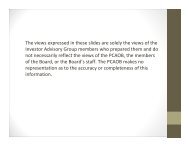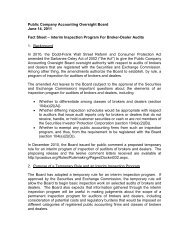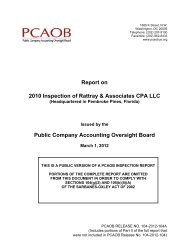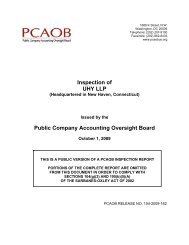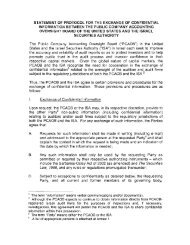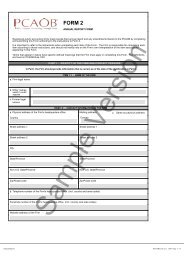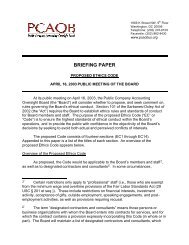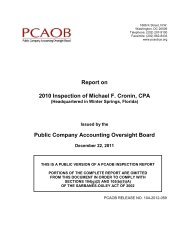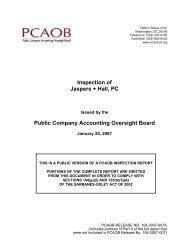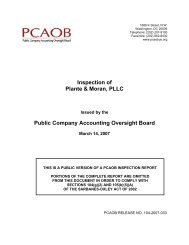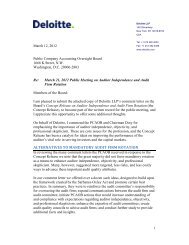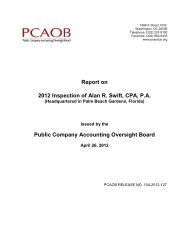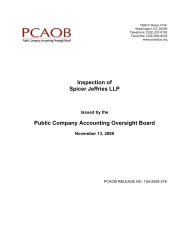Inspection of Michael F. Albanese CPA Public Company Accounting ...
Inspection of Michael F. Albanese CPA Public Company Accounting ...
Inspection of Michael F. Albanese CPA Public Company Accounting ...
Create successful ePaper yourself
Turn your PDF publications into a flip-book with our unique Google optimized e-Paper software.
1666 K Street, N.W.<br />
Washington, DC 20006<br />
Telephone: (202) 207-9100<br />
Facsimile: (202) 862-8430<br />
www.pcaobus.org<br />
<strong>Inspection</strong> <strong>of</strong><br />
<strong>Michael</strong> F. <strong>Albanese</strong> <strong>CPA</strong><br />
Issued by the<br />
<strong>Public</strong> <strong>Company</strong> <strong>Accounting</strong> Oversight Board<br />
September 30, 2008<br />
THIS IS A PUBLIC VERSION OF A PCAOB INSPECTION REPORT<br />
PORTIONS OF THE COMPLETE REPORT ARE OMITTED<br />
FROM THIS DOCUMENT IN ORDER TO COMPLY WITH<br />
SECTIONS 104(g)(2) AND 105(b)(5)(A)<br />
OF THE SARBANES-OXLEY ACT OF 2002<br />
PCAOB RELEASE NO. 104-2008-178A<br />
(Includes portions <strong>of</strong> Parts II and IV <strong>of</strong> the full report that<br />
were not included in PCAOB Release No. 104-2008-178)
PCAOB Release No. 104-2008-178A<br />
Notes Concerning this Report<br />
1. Portions <strong>of</strong> this report may describe deficiencies or potential deficiencies in the systems,<br />
policies, procedures, practices, or conduct <strong>of</strong> the firm that is the subject <strong>of</strong> this report.<br />
The express inclusion <strong>of</strong> certain deficiencies and potential deficiencies, however, should<br />
not be construed to support any negative inference that any other aspect <strong>of</strong> the firm's<br />
systems, policies, procedures, practices, or conduct is approved or condoned by the<br />
Board or judged by the Board to comply with laws, rules, and pr<strong>of</strong>essional standards.<br />
2. Any references in this report to violations or potential violations <strong>of</strong> law, rules, or<br />
pr<strong>of</strong>essional standards should be understood in the supervisory context in which this<br />
report was prepared. Any such references are not a result <strong>of</strong> an adversarial adjudicative<br />
process and do not constitute conclusive findings <strong>of</strong> fact or <strong>of</strong> violations for purposes <strong>of</strong><br />
imposing legal liability. Similarly, any description herein <strong>of</strong> a firm's cooperation in<br />
addressing issues constructively should not be construed, and is not construed by the<br />
Board, as an admission, for purposes <strong>of</strong> potential legal liability, <strong>of</strong> any violation.<br />
3. Board inspections encompass, among other things, whether the firm has failed to<br />
identify departures from U.S. Generally Accepted <strong>Accounting</strong> Principles ("GAAP") or<br />
Securities and Exchange Commission ("SEC" or "Commission") disclosure requirements<br />
in its audits <strong>of</strong> financial statements. This report's descriptions <strong>of</strong> any such auditing<br />
failures necessarily involve descriptions <strong>of</strong> the related GAAP or disclosure departures.<br />
The Board, however, has no authority to prescribe the form or content <strong>of</strong> an issuer's<br />
financial statements. That authority, and the authority to make binding determinations<br />
concerning an issuer's compliance with GAAP or Commission disclosure requirements,<br />
rests with the Commission. Any description, in this report, <strong>of</strong> perceived departures from<br />
GAAP or Commission disclosure requirements should not be understood as an<br />
indication that the Commission has considered or made any determination regarding<br />
these issues unless otherwise expressly stated.
PCAOB Release No. 104-2008-178A<br />
INSPECTION OF MICHAEL F. ALBANESE <strong>CPA</strong><br />
The <strong>Public</strong> <strong>Company</strong> <strong>Accounting</strong> Oversight Board ("PCAOB" or "the Board") has<br />
conducted an inspection <strong>of</strong> the registered public accounting firm <strong>Michael</strong> F. <strong>Albanese</strong><br />
<strong>CPA</strong>. The Board is issuing this report <strong>of</strong> that inspection in accordance with the<br />
requirements <strong>of</strong> the Sarbanes-Oxley Act <strong>of</strong> 2002 ("the Act").<br />
The Board is making portions <strong>of</strong> the report publicly available. Specifically, the<br />
Board is releasing to the public Part I <strong>of</strong> the report and portions <strong>of</strong> Part IV <strong>of</strong> the report.<br />
Part IV <strong>of</strong> the report consists <strong>of</strong> the Firm's comments, if any, on a draft <strong>of</strong> the report. 1/<br />
The Board has elsewhere described in detail its approach to making inspectionrelated<br />
information publicly available consistent with legal restrictions. 2/ A substantial<br />
portion <strong>of</strong> the Board's criticisms <strong>of</strong> a firm (specifically criticisms <strong>of</strong> the firm's quality<br />
control system), and the Board's dialogue with the firm about those criticisms, occurs<br />
out <strong>of</strong> public view, unless the firm fails to make progress to the Board's satisfaction in<br />
addressing those criticisms. In addition, the Board generally does not disclose<br />
otherwise nonpublic information, learned through inspections, about the firm or its<br />
clients. Accordingly, information in those categories generally does not appear in the<br />
publicly available portion <strong>of</strong> an inspection report.<br />
1/<br />
The Board does not make public any <strong>of</strong> a firm's comments that address a<br />
nonpublic portion <strong>of</strong> the report unless a firm specifically requests otherwise. In addition,<br />
pursuant to section 104(f) <strong>of</strong> the Act, 15 U.S.C. § 7214(f), and PCAOB Rule 4007(b), if a<br />
firm requests, and the Board grants, confidential treatment for any <strong>of</strong> the firm's<br />
comments on a draft report, the Board does not include those comments in the final<br />
report at all. The Board routinely grants confidential treatment, if requested, for any<br />
portion <strong>of</strong> a firm's response that addresses any point in the draft that the Board omits<br />
from, or any inaccurate statement in the draft that the Board corrects in, the final report.<br />
2/<br />
See Statement Concerning the Issuance <strong>of</strong> <strong>Inspection</strong> Reports, PCAOB<br />
Release No. 104-2004-001 (August 26, 2004).
PCAOB Release No. 104-2008-178A<br />
<strong>Inspection</strong> <strong>of</strong> <strong>Michael</strong> F. <strong>Albanese</strong> <strong>CPA</strong><br />
September 30, 2008<br />
Page 2<br />
PART I<br />
INSPECTION PROCEDURES AND CERTAIN OBSERVATIONS<br />
Members <strong>of</strong> the Board's inspection staff ("the inspection team") conducted<br />
fieldwork for the inspection from May 29, 2007 to June 4, 2007. The fieldwork included<br />
procedures tailored to the nature <strong>of</strong> the Firm, certain aspects <strong>of</strong> which the inspection<br />
team understood at the outset <strong>of</strong> the inspection to be as follows:<br />
Number <strong>of</strong> <strong>of</strong>fices<br />
Ownership structure<br />
1 (Parsippany, New Jersey)<br />
Sole practitioner<br />
Number <strong>of</strong> partners 1<br />
Number <strong>of</strong> pr<strong>of</strong>essional staff 3/<br />
None<br />
Number <strong>of</strong> issuer audit clients 4/ 1<br />
Board inspections are designed to identify and address weaknesses and<br />
deficiencies related to how a firm conducts audits. 5/ To achieve that goal, Board<br />
inspections include reviews <strong>of</strong> certain aspects <strong>of</strong> selected audits performed by the firm<br />
and reviews <strong>of</strong> other matters related to the firm's quality control system.<br />
3/<br />
"Pr<strong>of</strong>essional staff" includes all personnel <strong>of</strong> the Firm, except partners or<br />
shareholders and administrative support personnel.<br />
4/<br />
The number <strong>of</strong> issuer audit clients shown here is based on the Firm's selfreporting<br />
and the inspection team's review <strong>of</strong> certain information for inspection planning<br />
purposes. It does not reflect any Board determination concerning which, or how many,<br />
<strong>of</strong> the Firm's audit clients are "issuers" as defined in the Act. In some circumstances, a<br />
Board inspection may include a review <strong>of</strong> a firm's audit <strong>of</strong> financial statements <strong>of</strong> an<br />
issuer that ceased to be an audit client before the inspection, and any such former<br />
clients are not included in the number shown here.<br />
5/<br />
This focus necessarily carries through to reports on inspections and,<br />
accordingly, Board inspection reports are not intended to serve as balanced report<br />
cards or overall rating tools.
PCAOB Release No. 104-2008-178A<br />
<strong>Inspection</strong> <strong>of</strong> <strong>Michael</strong> F. <strong>Albanese</strong> <strong>CPA</strong><br />
September 30, 2008<br />
Page 3<br />
In the course <strong>of</strong> reviewing aspects <strong>of</strong> selected audits, an inspection may identify<br />
ways in which a particular audit is deficient, including failures by the firm to identify, or to<br />
address appropriately, respects in which an issuer's financial statements do not present<br />
fairly the financial position, results <strong>of</strong> operations, or cash flows <strong>of</strong> the issuer in<br />
conformity with GAAP. 6/ It is not the purpose <strong>of</strong> an inspection, however, to review all <strong>of</strong><br />
a firm's audits or to identify every respect in which a reviewed audit is deficient.<br />
Accordingly, a Board inspection report should not be understood to provide any<br />
assurance that the firm's audits, or its issuer clients' financial statements, are free <strong>of</strong> any<br />
deficiencies not specifically described in an inspection report.<br />
A. Review <strong>of</strong> Audit Engagement<br />
The inspection procedures included a review <strong>of</strong> aspects <strong>of</strong> the Firm's auditing <strong>of</strong><br />
financial statements <strong>of</strong> one issuer. The scope <strong>of</strong> this review was determined according<br />
to the Board's criteria, and the Firm was not allowed an opportunity to limit or influence<br />
the scope.<br />
The inspection team identified what it considered to be audit deficiencies. 7/ The<br />
deficiencies identified in the audit reviewed included a deficiency <strong>of</strong> such significance<br />
that it appeared to the inspection team that the Firm did not obtain sufficient competent<br />
evidential matter to support its opinion on the issuer's financial statements. 8/ That<br />
6/<br />
When it comes to the Board's attention that an issuer's financial<br />
statements appear not to present fairly, in a material respect, the financial position,<br />
results <strong>of</strong> operations, or cash flows <strong>of</strong> the issuer in conformity with GAAP, the Board's<br />
practice is to report that information to the SEC, which has jurisdiction to determine<br />
proper accounting in issuers' financial statements.<br />
7/<br />
PCAOB standards require a firm to take appropriate actions to assess the<br />
importance <strong>of</strong> audit deficiencies identified after the date <strong>of</strong> the audit report to the firm's<br />
present ability to support its previously expressed opinions. See AU 390, Consideration<br />
<strong>of</strong> Omitted Procedures After the Report Date, and AU 561, Subsequent Discovery <strong>of</strong><br />
Facts Existing at the Date <strong>of</strong> the Auditor's Report (both included among the PCAOB's<br />
interim auditing standards, pursuant to PCAOB Rule 3200T). Failure to comply with<br />
these PCAOB standards could be a basis for Board disciplinary sanctions.<br />
8/<br />
In some cases, an inspection team's observation that a firm failed to<br />
perform a procedure may be based on the absence <strong>of</strong> documentation and the absence
PCAOB Release No. 104-2008-178A<br />
<strong>Inspection</strong> <strong>of</strong> <strong>Michael</strong> F. <strong>Albanese</strong> <strong>CPA</strong><br />
September 30, 2008<br />
Page 4<br />
deficiency was the failure to perform sufficient audit procedures to evaluate the<br />
appropriateness <strong>of</strong> the issuer's accounting related to the conversion <strong>of</strong> debt to common<br />
stock.<br />
The deficiency described above related to auditing an aspect <strong>of</strong> an issuer's<br />
financial statements that the issuer revised in a restatement subsequent to inspection<br />
fieldwork. 9/<br />
B. Review <strong>of</strong> Quality Control System<br />
In addition to evaluating the quality <strong>of</strong> the audit work performed on a specific<br />
audit, the inspection included review <strong>of</strong> certain <strong>of</strong> the Firm's practices, policies, and<br />
procedures related to audit quality. This review addressed practices, policies, and<br />
procedures concerning audit performance, training, compliance with independence<br />
standards, client acceptance and retention, and the establishment <strong>of</strong> policies and<br />
procedures. As described above, any defects in, or criticisms <strong>of</strong>, the Firm's quality<br />
control system are discussed in the nonpublic portion <strong>of</strong> this report and will remain<br />
nonpublic unless the Firm fails to address them to the Board's satisfaction within 12<br />
months <strong>of</strong> the date <strong>of</strong> this report.<br />
END OF PART I<br />
<strong>of</strong> persuasive other evidence, even if a firm claims to have performed the procedure.<br />
PCAOB Auditing Standard No. 3, Audit Documentation ("AS No. 3"), provides that, in<br />
various circumstances including PCAOB inspections, a firm that has not adequately<br />
documented that it performed a procedure, obtained evidence, or reached an<br />
appropriate conclusion must demonstrate with persuasive other evidence that it did so,<br />
and that oral assertions and explanations alone do not constitute persuasive other<br />
evidence. See AS No. 3, paragraph 9; Appendix A to AS No. 3, paragraph A28. For<br />
purposes <strong>of</strong> the inspection, an observation that the Firm did not perform a procedure,<br />
obtain evidence, or reach an appropriate conclusion may be based on the absence <strong>of</strong><br />
such documentation and the absence <strong>of</strong> persuasive other evidence.<br />
9/<br />
The Board inspection process did not include review <strong>of</strong> any additional<br />
audit work related to the restatement.
PCAOB Release No. 104-2008-178A<br />
<strong>Inspection</strong> <strong>of</strong> <strong>Michael</strong> F. <strong>Albanese</strong> <strong>CPA</strong><br />
September 30, 2008<br />
Page 5<br />
PORTIONS OF THE REST OF THIS REPORT ARE NONPUBLIC AND ARE OMITTED<br />
FROM THIS PUBLIC DOCUMENT
PCAOB Release No. 104-2008-178A<br />
<strong>Inspection</strong> <strong>of</strong> <strong>Michael</strong> F. <strong>Albanese</strong> <strong>CPA</strong><br />
September 30, 2008<br />
Page 6<br />
PART II<br />
* * * *<br />
B. Issues Related to Quality Controls<br />
The inspection <strong>of</strong> the Firm included consideration <strong>of</strong> aspects <strong>of</strong> the Firm's system<br />
<strong>of</strong> quality control. Assessment <strong>of</strong> a firm's quality control system rests both on review <strong>of</strong><br />
a firm's stated quality control policies and procedures and on inferences that can be<br />
drawn from respects in which a firm's system has failed to assure quality in the actual<br />
performance <strong>of</strong> engagements. 10/ On the basis <strong>of</strong> the information reported by the<br />
inspection team, the Board has the following concerns about aspects <strong>of</strong> the Firm's<br />
system <strong>of</strong> quality control.<br />
Audit Performance<br />
A firm's system <strong>of</strong> quality control should provide reasonable assurance that the<br />
work performed on an audit engagement will meet applicable pr<strong>of</strong>essional standards<br />
and regulatory requirements. On the basis <strong>of</strong> the information reported by the inspection<br />
team, including the audit performance deficiency described in Part II.A and any other<br />
deficiencies identified below, the Board has concerns that the Firm's system <strong>of</strong> quality<br />
control fails to provide such reasonable assurance in at least the following respects 11/ –<br />
10/<br />
A firm's failure to comply with the requirements <strong>of</strong> PCAOB standards when<br />
performing an audit may be an indication <strong>of</strong> a potentially significant defect in a firm's<br />
quality control system even if that failure did not result in an insufficiently supported<br />
audit opinion.<br />
11/<br />
In addition to the points described in the text, the Board notes that the<br />
concurring partner review procedure used by the Firm for the issuer inspected did not<br />
result in the identification <strong>of</strong> the deficiency noted by the inspection team. Because the<br />
Firm was not a member <strong>of</strong> the SEC Practice Section <strong>of</strong> the American Institute <strong>of</strong><br />
Certified <strong>Public</strong> Accountants and therefore is not subject to the concurring partner<br />
review requirement in the Board's interim standards, the Board is not here addressing<br />
the concurring partner review procedures in terms <strong>of</strong> a criticism <strong>of</strong>, or a potential defect<br />
in, the Firm's quality control systems for purposes <strong>of</strong> PCAOB Rule 4009 (discussed in<br />
Part III below). Nevertheless, the Board notes the important role that an effective<br />
concurring partner review can play in ensuring that an audit is performed in compliance
PCAOB Release No. 104-2008-178A<br />
<strong>Inspection</strong> <strong>of</strong> <strong>Michael</strong> F. <strong>Albanese</strong> <strong>CPA</strong><br />
September 30, 2008<br />
Page 7<br />
a. Technical Competence, Due Care, and Pr<strong>of</strong>essional Skepticism<br />
The Firm's system <strong>of</strong> quality control appears not to do enough to ensure<br />
technical competence and the exercise <strong>of</strong> due care or pr<strong>of</strong>essional skepticism.<br />
b. Engagement Completion Document<br />
The Firm's system <strong>of</strong> quality control appears not to provide sufficient assurance<br />
that the Firm will prepare an engagement completion document in accordance with AS<br />
No. 3 which is necessary to demonstrate that the work performed by engagement<br />
personnel addresses the significant findings and issues <strong>of</strong> the engagement. [Issuer A]<br />
c. Auditor Communications<br />
The Firm's system <strong>of</strong> quality control appears not to provide sufficient assurance<br />
that the required auditor communications to the audit committee, or equivalent, occur<br />
and are appropriately documented. [Issuer A]<br />
* * * *<br />
with PCAOB standards, and encourages the Firm to obtain a meaningful concurring<br />
partner review by a qualified reviewer in connection with audits <strong>of</strong> issuers. A meaningful<br />
concurring partner review procedure would likely have identified the deficiencies<br />
described in this report before the Firm issued the reports.
PCAOB Release No. 104-2008-178A<br />
<strong>Inspection</strong> <strong>of</strong> <strong>Michael</strong> F. <strong>Albanese</strong> <strong>CPA</strong><br />
September 30, 2008<br />
Page 8<br />
PART IV<br />
RESPONSE OF THE FIRM TO DRAFT INSPECTION REPORT<br />
Pursuant to section 104(f) <strong>of</strong> the Act, 15 U.S.C. § 7214(f), and PCAOB Rule<br />
4007(a), the Firm provided a written response to a draft <strong>of</strong> this report. Pursuant to<br />
section 104(f) <strong>of</strong> the Act and PCAOB Rule 4007(b), the Firm's response, minus any<br />
portion granted confidential treatment, is attached hereto and made part <strong>of</strong> this final<br />
inspection report. 12/<br />
12/<br />
In any version <strong>of</strong> an inspection report that the Board makes publicly<br />
available, any portions <strong>of</strong> a firm's response that address nonpublic portions <strong>of</strong> the report<br />
are omitted. In some cases, the result may be that none <strong>of</strong> a firm's response is made<br />
publicly available.



